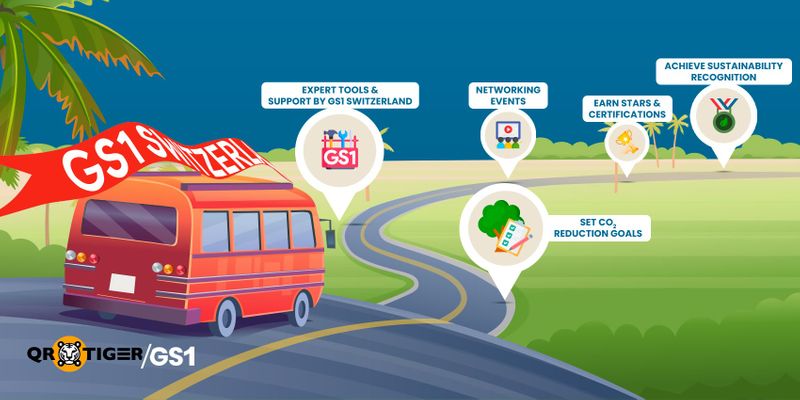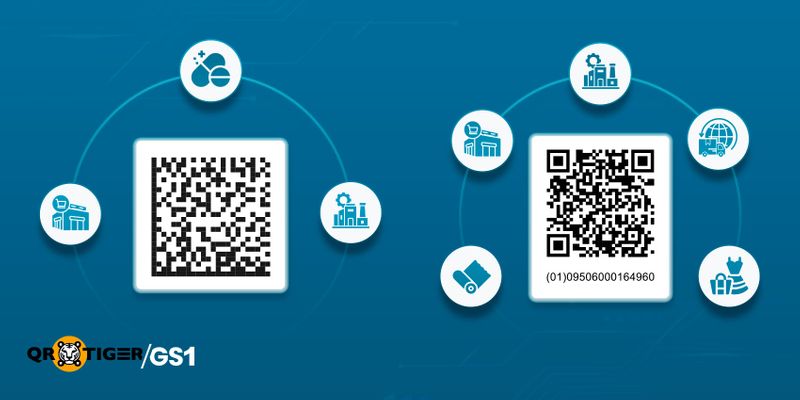GS1 Switzerland: Digital Standards Across Swiss Industries

Swiss businesses continue to leverage GS1 standards to drive digitalization, ensure traceability, and meet evolving regulatory and market demands.
These standards offer standardized identification systems and data-sharing frameworks that support more than 8,600 companies across sectors—from healthcare to technical industries.
By enabling efficient data sharing, smooth product identification, and transparent supply chain processes, these standards empower organizations to boost operational performance and meet sustainability goals.
Table of Contents
- What is GS1 Switzerland?
- Introduced initiatives and collaborated campaigns
- GS1 SUI services for businesses
- Applications of 2D barcodes across industries in Switzerland
- Inspiring success stories from GS1 in Switzerland
- Cadila ensured product transparency
- Drive innovation and business success with GS1 CH
- Frequently asked questions
What is GS1 Switzerland?
GS1 Switzerland (SUI) is a member organization (MO) of the neutral and not-for-profit GS1 international organization. It develops and facilitates the adoption of easy-to-implement global standards for business.
The local GS1 chapter helps businesses work smarter by using global standards that improve how goods, information, and value move through supply chains. The organization supports companies by sharing practical knowledge and developing clear standards and process guidelines in collaboration with its members.
It promotes transparency, security, and efficiency across sectors. These efforts strengthen industry performance and also support economic growth.
With flexible tools and systems, GS1 standards make it easy to collect, use, and share information in a consistent way. They enable standardized data flow across the global market.
Introduced initiatives and collaborated campaigns
GS1 SUI partners with companies and industry groups to improve data sharing, strengthen supply chains, and support digital transformation. With various collaborative projects and targeted initiatives, it helps businesses adopt global standards that improve traceability, efficiency, and sustainability across sectors.
Project firstbase healthcare
GS1 SUI plays a key role in improving healthcare efficiency and safety by enabling standardized product identification and data sharing. Through its Firstbase Healthcare initiative, GS1 SUI helps hospitals and suppliers manage medical products using globally recognized GS1 standards, ensuring accurate tracking from manufacturer to patient.
By using GS1 identifiers like GTINs and barcodes, healthcare providers in Switzerland can streamline inventory management, reduce errors, and enhance traceability.
This system supports better decision-making, faster recalls, and improved patient care—all while meeting regulatory requirements and promoting transparency across the healthcare supply chain.
Solution Partner Programme
The program connects companies with experts skilled at how to apply GS1 standards. These partners support businesses in improving barcode use, managing product data, and streamlining logistic operations.
Whether it’s tracking products, fixing barcode issues, or making supply chains more efficient, the program assists companies in finding the right support.
For solution providers, joining the program helps build trust and boost visibility in the GS1 network. It provides them opportunities to work on real projects, learn more about the latest innovations, and share ideas at events.
Initiative Lean & Green

GS1 SUI is the official host and organizer of the Lean & Green program in Switzerland. With the goal of helping companies reduce transport and logistics emissions. Businesses determine their own CO₂ reduction goals and follow a step-by-step plan. As they complete each target, they earn stars and certifications that acknowledge their progress.
The program provides support through guidance, expert tools, and a network of like-minded companies. The local GS1 chapter also hosts regular events allowing participants to share ideas, find joint solutions, and learn from each other.
This initiative lowers environmental impact, reduces costs, and also boosts efficiency. By joining this initiative, companies show their dedication to sustainability and get recognition through special awards.
By advancing transparency and traceability in supply chains, GS1 SUI plays a crucial role in supporting the country’s sustainability efforts.
Event partner
GS1 SUI partners with organizations as an event partner to support discussions on current industry topics. These partnerships focus on specific themes that match the local GS1 chapter’s objective of setting standards and improving supply chains.
By participating or co-hosting events like workshops, conferences, and networking sessions, GS1 SUI brings together experts, companies, and professionals to share unique ideas and find real-world solutions.
These events help promote the use of GS1 standards and strengthen connections across industries.
GS1 SUI services for businesses
GTIN Registry & Barcode Services: GS1 CH offers a free GTIN Registry to allow its members to easily and accurately manage product identification. Members can create and manage Global Trade Item Numbers (GTINs), with check digits calculated automatically.
The tool also allows users to generate EAN-13 barcodes and QR codes using GS1 Digital Link.
Members can upload product images and enter structured master data to keep everything organized. So, each product is uniquely identified and ready for sale in online marketplaces and physical stores.
firstbase: GS1 CH’s firstbase is a central, easy-to-use platform helping businesses share precise product data with partners. It is made for the Swiss market but is linked globally.
It allows manufacturers and suppliers to upload, check, and send product info (like images, descriptions, and logistics data) through a system link, web portal, or Global Data Synchronization Network (GDSN) connection. This ensures that all stakeholders get updated, verified data for their purchasing needs and supply chain.
GLN Services: The service provides businesses with a unique ID for each location or unit (like factories, warehouses, or billing offices). This helps clearly label and manage sites in supply chains, logistics systems, and invoices.
With the GLN-10 package, companies can register up to 10 locations for CHF 200 per year (excluding VAT). They can also use the GLN Search platform to publish and check GLNs, making it simpler for partners to find and validate accurate location data.
GS1 Print: This service helps businesses create standard transport labels for efficient and clear logistics. These labels use the GS1-128 barcode and contain key details like the Serial Shipping Container Code (SSCC), quantities, product GTINs, and optional info (like weights or batch numbers).
The SSCC is a unique 18-digit number facilitating accurate tracking from sender to receiver. Note that GS1 Print is free for members and operates through a web interface using a regular printer and label paper.
SAN (Standard Article Number): The local GS1 chapter’s SAN service provides four-digit codes to label variable-weight fresh products like vegetables, fruits, dairy, and meat. These codes help ensure consistent labeling, especially when prices depend on weight.
No new SANs have been issued since 2018, but GS1 CH still supports a catalog of existing codes for older systems. Currently, they recommend switching to globally unique GTINs with 2D barcodes, like GS1 DataBar or GS1 DataMatrix, for better traceability and compatibility with modern retail systems.
LEI (Legal Entity Identifier): LEI service helps companies adhere to Swiss and EU rules by providing a unique 20-character code that identifies legal entities in financial transactions. Since January 1, 2022, GS1 Germany administers this service for Swiss businesses.
Investment funds, banks, insurers, and others can apply for, renew, or transfer their LEIs through this partnership. So, it ensures clear identification, traceability, and transparency in financial reporting.
Continuing education programme: The local GS1 chapter provides a flexible training program to help logistics and supply chain professionals stay updated about trends. It supports online courses, on-site seminars, and webinars for both individuals and teams.
Courses are available for all levels—from beginners to senior managers. They focus on using GS1 standards in practical use cases. Note that the training is led by experts with support from GS1’s partner network.
Whether to build basic knowledge or sharpen strategy, the program gives professionals the tools to stay ahead in today’s digital economy.
Applications of 2D barcodes across industries in Switzerland
As a part of the GS1 Sunrise initiative, retailers worldwide are encouraged to integrate 2D barcodes (such as Data Matrix and GS1 QR codes) into their point of sale (POS) and supply chain systems by 2027.
The transition is not a mandate. 1D barcodes will continue to be used. The use of 1D barcodes remains permissible until an industry or government regulation mandatorily shifts is enforced.
During this transition period, it is recommended to include both the 1D and 2D barcodes on the packaging to ensure compatibility with retailers who have yet not incorporated 2D barcodes on their packaging.
GS1 Digital Link: This standard transforms regular barcodes into smart QR codes that link products to online information. With the addition of a product’s GTIN to a web link, consumers can access details like product origin, ingredients, current offers, and how to recycle -all with one scan.
These links can be updated anytime without modifying the printed code. GS1 CH also provides a Digital Link Resolver, allowing members to manage and redirect these links easily and safely.
Using the GS1 QR code for detailed product information, consumers and stakeholders can stay updated about comprehensive product information (product origins, certifications, etc.) and thus ensure supply chain transparency.

It relies on companies whether to develop their own software by following GS1’s implementation guidance and standards documentation or use a third-party service like GS1 QR code generator by QR Tiger to encode product data using GS1 formats.
Some of the key applications of these codes across industries in Switzerland are discussed here:
Retail
2D barcodes, like the GS1 Digital Link QR code, are changing how products are labeled in Swiss retail. These smart codes carry a product number, batch info, expiry dates, and also direct shoppers to videos or allergy warnings.
The shopping becomes more transparent and reliable with a quick scan on their phone. GS1 CH helps retailers use these codes by providing ready-to-use formats and toolkits. This ensures the new barcodes work smoothly across supply chains, packaging, and checkout systems.
Healthcare
Hospitals and pharmacies in Switzerland use GS1 DataMatrix codes to track medical devices, medicines, and treatments. These compact 2D codes fit on even the tiniest packages and carry essential details like expiry dates and serial numbers.
This helps avoid mistakes, keeps patients safe, and makes recalls easier. The local GS1 chapter supports this by ensuring these systems follow global healthcare standards, so everything works smoothly and as per global compliance.
Manufacturing
Swiss manufacturers use 2D barcodes to manage parts, track production, and optimize inventory management. A quick scan can display where a part came from, when it was made, and if it passed quality checks. This helps factories work efficiently, resolve issues quickly, and reduce delays.
The local GS1 chapter supports this by giving companies the right data standards and tools. These ensure the barcodes work smoothly across factory systems and with various suppliers.
Logistics
In logistics, 2D barcodes on packages and pallets help make warehouse operations faster and more accurate. These codes allow effective tracking, reduce manual errors, and make it easier to trace products through the supply chain.
They also support greener transport by helping companies plan better delivery routes, reducing CO₂ emissions, and saving on fuel. Many businesses now use GS1 QR code for inventory and supply chain logistics to boost visibility and speed across their operations.
Driven by the need for greater supply chain transparency and efficiency, GS1 CH’s 2D barcode standards are supporting smarter logistics solutions nationwide.
Fashion & Textiles
In Switzerland, brands like Calida use 2D barcodes to show customers how and where their clothes were made. Depending on the setup, shoppers can scan the label that may contain the full journey of a product, from raw materials to final stitching. This helps support ethical sourcing and sustainability.
The GS1 helps fashion companies use Digital Link URI and 2D barcode standards to fulfill customer expectations and follow updated EU rules. These tools make it simpler to share product details and build trust through transparency.
Inspiring success stories from GS1 in Switzerland
GS1 Switzerland has supported companies across industries in improving efficiency, traceability, and sustainability through the smart use of global standards. The following success stories highlight how businesses have implemented GS1 solutions to solve real-world challenges and drive innovation.
Cadila ensured product transparency
Calida, a Swiss clothing brand, worked with GS1 CH to make its products more transparent and traceable. The objective was to let customers scan a QR code on the label and immediately see details like the materials’ origin, manufacturing place, and how it supports sustainability.
This was done using Digital Link powered by GS1 and GS1 2D barcode, which connects each product to digital information in a standard format. Hence, shoppers can now trace the full journey of a product—from raw materials to the final item.
Drive innovation and business success with GS1 CH
GS1 Switzerland helps businesses across the country work in a more organized and efficient way. By offering global standards that fit local needs, it supports better product tracking, smoother operations, and stronger data sharing between partners.
Its efforts, like promoting 2D barcodes, supporting digital product passports, and running programs such as Lean & Green, give companies the tools to keep up with modern demands and follow important rules.
As industries face growing pressure to be more transparent and accurate, GS1 role becomes even more important. Businesses that use its services are better prepared to improve how they work, reduce mistakes, and meet future challenges with confidence.
Frequently asked questions
How do I know how many barcodes I need?
The number of barcodes you require depends on the number of variants (color, size, flavor, etc.) of the product your business offers. GS1 SUI provides various package sizes based on your needs.
Suppose there are 10 T-shirts, 9 color options, and 4 sizes. Hence, the number of barcodes you need is 10*9*4 = 360.
How do I become a GS1 SUI member?
To become a member of GS1 SUI, visit www.gs1.ch.There, you’ll find all the details and an application form. As a member, you’ll also get access to helpful services like expert advice and training.
DISCLAIMER: We acknowledge that GS1, as well as the materials, proprietary items, and all related patents, copyright, trademark, and other intellectual property (collectively, “intellectual property”) relating to its use, are the property of GS1 Global, and that our use of the same shall be in accordance with the conditions provided by GS1 Global.




